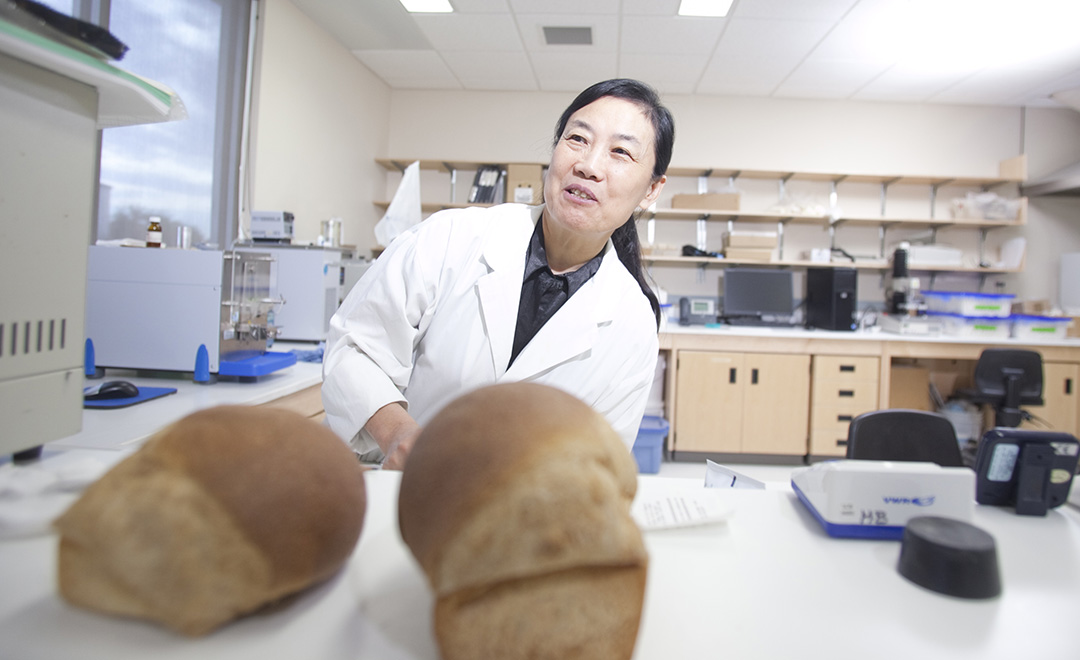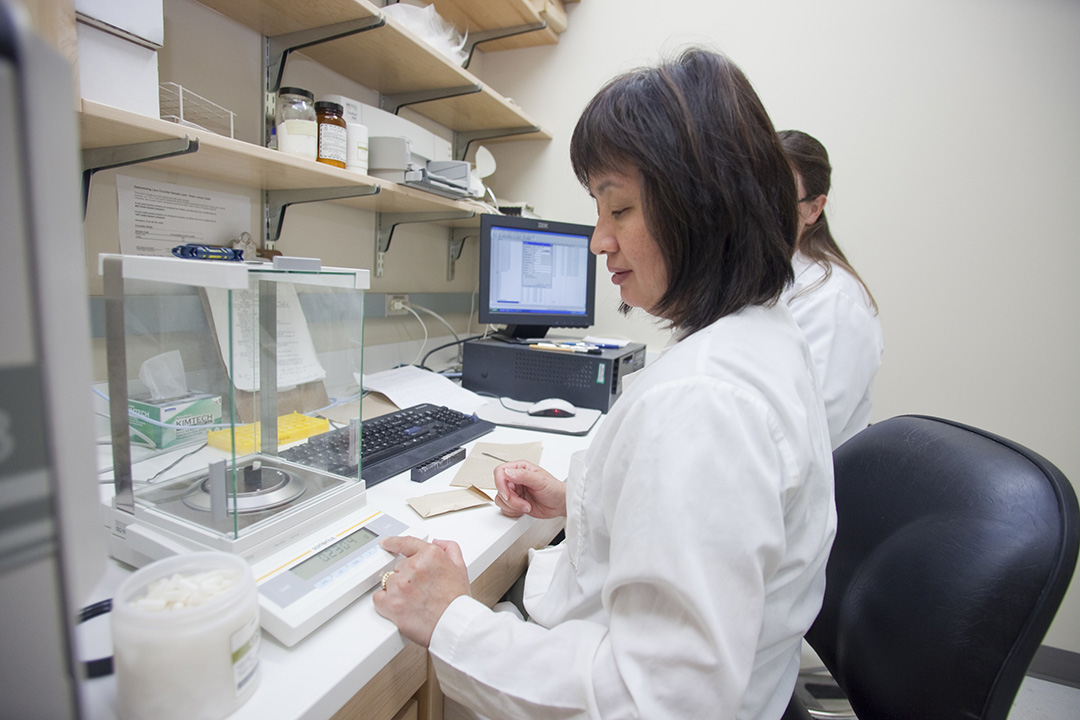
USask’s CDC celebrates a half century of crop innovation
A scan across the horizon reveals how much Saskatchewan’s agricultural landscape has changed in half a century: millions of acres of ripening lentils, fields of sky blue flax, and stubble poking through snowy expanses, ready to receive springtime’s direct-seeded crop.
By Kathy Fitzpatrick for USask Research Profile and ImpactMuch of the credit for all this goes to the Crop Development Centre (CDC) at the University of Saskatchewan’s College of Agriculture and Bioresources. Launched in 1971 to help producers diversify and farm more productively and profitably, the CDC celebrates its 50th anniversary this year.
“Over half a century, our renowned CDC research has supported producers and agribusiness, helping to make the province a world leader in agriculture,” said USask Vice-President Research Karen Chad.
The CDC has released more than 500 new crop varieties—an average of 100 for each decade—which CDC Director Curtis Pozniak calls “remarkable.” It’s the work of dedicated people in a research centre that today includes over 200 staff and graduate students, with expertise not only in plant breeding but also research into crop diseases and end-use quality.
Depending on the crop, improved traits include earlier maturity, higher yield, and disease resistance. CDC research has substantially reduced the heavy metal cadmium taken up from the soil into durum grain.
Saskatchewan now leads the world in exporting peas, lentils, and chickpeas—staple foods in fast-growing countries such as India, China, Bangladesh, and northern Africa.
The CDC’s Pierre Hucl developed the first hairless canary seed which has helped make Saskatchewan the world’s leading producer and exporter of canary seed, with exports of $100 million a year.
And more recently, the CDC has led some global science breakthroughs such as cracking the wheat genetic code.
A combination of plant breeding expertise, facilities and land—all in one place—has made the CDC “the greatest plant breeding and crop development organization ever established in Canada,” said Emeritus Professor Gordon Rowland, former CDC director and flax breeder.

Carl Potts, executive director of Saskatchewan Pulse Growers, stresses other keys to the CDC’s success are committed scientists and staff, connected to “one of the strongest agricultural universities in Canada” and centred in the country’s major grain-growing region.
Improved production practices such as replacement of summer fallowing with zero tillage was an unforeseen but welcome spinoff for producers. Crop diversification from USask-developed varieties—as well as new seeding technologies for precise seed and fertilizer placement—significantly reduced Saskatchewan acreage under summer fallow, increasing seeded acreage by more than 40 per cent since 1970.
The results have been three-fold: more land being used to produce food, higher returns for farmers, and more crop choices for producers than ever before. Estimates are that this decrease in fallow land alone has had an impact on the Saskatchewan economy of $50 billion since 1970.
Over the years, the CDC’s impact has been “enormous,” said former CDC director Bryan Harvey who developed, along with Brian Rossnagel, the malting barley Harrington which became a leading choice of North American producers.
For every $1 million invested in CDC plant breeding, producers saw a seven-fold return, according to the CDC’s 2016 economic impact report.
From 1991 to 2015, producer profitability across the three prairie provinces increased by $3.8 billion “as a result of CDC varieties provided to the marketplace,” the 2016 report found. There is little doubt the CDC continues to wield an impact of this scale.
Along with investments from the Saskatchewan Ministry of Agriculture (averaging $5.7 million annually over the 10 years preceding the report’s release), millions of dollars in producer checkoffs, royalties, research grants and breeding agreements flow in from industry, producer groups and government agencies, along with significant indirect funding and infrastructure support from USask.
The report also highlighted the CDC’s reach in terms of its basket of crops – bread wheat, durum, barley, oats, flax, field peas, lentils, chickpeas, canary seed, and dry beans. From 2011 to 2015, CDC varieties accounted for 37 per cent of the acreage grown for these crops in the three prairie provinces. Some crops clearly predominated: lentils (95 per cent, dry peas 85 per cent, flax seed 83 per cent, chickpeas 75 per cent, and canary seed 73 per cent).
The CDC has set a course for the future with a new vision—to be “a world-class crop improvement centre that delivers crop genetics for society.”
In 2019-20, the centre carried out 116 research projects worth more than $30 million, including $7.7 million for two large Genome Canada projects involving lentil and wheat.
CDC scientists are global leaders in the application of genomic research to crop improvement, having worked on sequencing the genomes of pea, chickpea, oat, tepary bean, and flax genomes.
Genome sequencing involves developing a DNA blueprint of the varieties used in breeding. “This gives scientists and breeders access to powerful DNA testing tools that can be used to improve efficiency in selection,” Pozniak said. For instance, if breeders can identify a gene that causes disease resistance, they can then develop a DNA tag (“a little fingerprint”) to select for that trait during cross breeding and aid in creating new and better varieties.
Pozniak’s team and Andrew Sharpe of the USask Global Institute for Food Security have played a key role in two major international consortia—one that sequenced the bread wheat genome, which is five times the size of the human genome, and another that sequenced the entire genome of durum wheat, the source of semolina for pasta.
In 2020, Pozniak led an international consortium of 95 scientists that sequenced 15 different wheat varieties bred around the world—the most comprehensive atlas of wheat genome sequences ever reported.
Kofi Agblor, who led the CDC from 2012 to 2019, foresees the ongoing importance of genomics as a platform for improving crops like wheat. “I think the best is yet to come,” he said.
Resistance to disease, pests and drought remain important goals at the CDC, especially in the face of climate change. But crops must also adapt to changing market demands, as world population rises while consumers hold out for choices that are healthier and more ecologically sustainable. Crops must also evolve to suit changing production and processing methods.
“As plant breeders, we have a lot of traits to consider and balance when creating new varieties,” Pozniak said.
It was a changing world that led to the CDC’s creation in the first place. In the late 1960s, a global glut drove down the price of wheat, the crop Saskatchewan farmers relied on most heavily. This prairie farm crisis provided the rationale for a bigger push in agricultural research, particularly in Saskatchewan which lacked a major plant breeding centre.
In its 1971 funding application to the National Research Council (NRC), the university made the case that with agricultural markets changing rapidly, prairie farmers had to diversify and lessen their dependence on wheat, while at the same time improving traditional crops (wheat and barley in particular) to meet world demands.
Another driving factor was that the crop science department was searching for more money to conduct research, hire staff, and attract graduate students. Given that Saskatchewan has almost half the arable crop land in Canada, the crop science department was “way understaffed for the responsibility that it had,” said Harvey, noting there were only four people doing field work.
More crop research was a tough sell in the midst of a declining wheat market. But Harvey pointed out the real risk in launching the CDC was the 15 or more years that was typically required at that time to develop and launch a new variety.
The NRC approved $455,100 over three years for research into feed barley, field peas and other new crops, and spring and winter wheat. The Province agreed to cover the $300,000 capital cost of the new crop science field laboratory, committed $200,000 annually for the first three years, and agreed to cover the CDC’s operating budget after the NRC term grant expired. In 1972, USask announced that an additional $100,000 had been set aside for growth room facilities to be built that summer.
Five years later, Fredrick Wesley Kernen’s large gift of farmland to USask led to the creation of the Kernen Crop Research Farm, another valuable resource for CDC crop breeders. In the decades to follow, much more would be invested by governments, industry and producer groups in improved and expanded infrastructure.
The CDC was initially staffed with six scientists working on feed and food barley, peas, winter wheat, and a few other areas. But some early game-changers released in the late 1970s and through the 1980s established the CDC’s reputation nationally and internationally.
Skill and timing were the common elements that catapulted not only the green Laird lentil to market dominance, but also Harrington two-row malt barley and Vimy flax. In all three cases, their spectacular success was ushered in by superior traits, combined with events such as droughts and crop failures of established varieties which created demand for the newly released CDC varieties.
CDC varieties also helped Saskatchewan become Canada’s top producer of lentils, flax and peas. Other releases included the first Canadian hulless barley and new varieties of hard red spring wheat, durum, and faba beans, to name a few.

More recently, CDC researchers Bunyamin Tar’an and Donna Lindsay have helped increase the genetic diversity of chickpeas through an international project that provides plant breeders with access to thousands of seed progeny from wild plants.
The close working relationship between the CDC’s malt barley breeders and the beer industry continues. Recently, head barley breeder Aaron Beattie led the “Bow Project”, featuring the new variety CDC Bow barley. Malted at the Maker’s Malt facility in Rosthern, 14 craft brewers in Saskatoon and Regina were then challenged to create new brews.
In the mid-2000s, the forage breeding program, which had begun in 1922 at USask and later moved to Agriculture and Agri-Food Canada’s Saskatchewan Research and Development Centre, became part of the CDC. Bill Biligetu works on salt-tolerant forage grasses, important as weather extremes become more common and producers deal with high soil salinity.
Addressing crop disease has been a CDC priority. In 2020, plant pathologist Sabine Banniza was awarded more than $1.3 million in Agricultural Development Fund for projects looking at plant root health in pulse crops.
CDC scientists have also distinguished themselves as mentors and teachers. Randy Kutcher, who developed a quick and accurate method to quantify toxins in fusarium-infected grain, was recently honored with the 2020 North American Colleges and Teachers of Agriculture Teaching Award of Merit.
Today, crop genetic improvement remains the centrepiece of the CDC’s work. A strategic research program for the period 2018-2023 lays out ambitious goals focusing on “improving the agronomic performance and the food and nutritional quality characteristics of pulse crops, cereals and flax for food, feed and industrial uses.”
Linked to this is the continuing aim for diversification to enable “development of new crop kinds, specialty varieties and market classes that add value and provide the basis for value-added processing and marketing to specialty end-users.” For example, Tom Warkentin, celebrated for his ground-breaking work on pea breeding and genomics, is developing new soybean varieties suitable for growing conditions across Western Canada.
Today, one thing in crop breeding remains unchanged—it still takes 10 to 12 years to develop a new variety. Pozniak embraces that challenge: peering into the future to figure out what will be next in demand is, he says, “what makes it so fun.”

